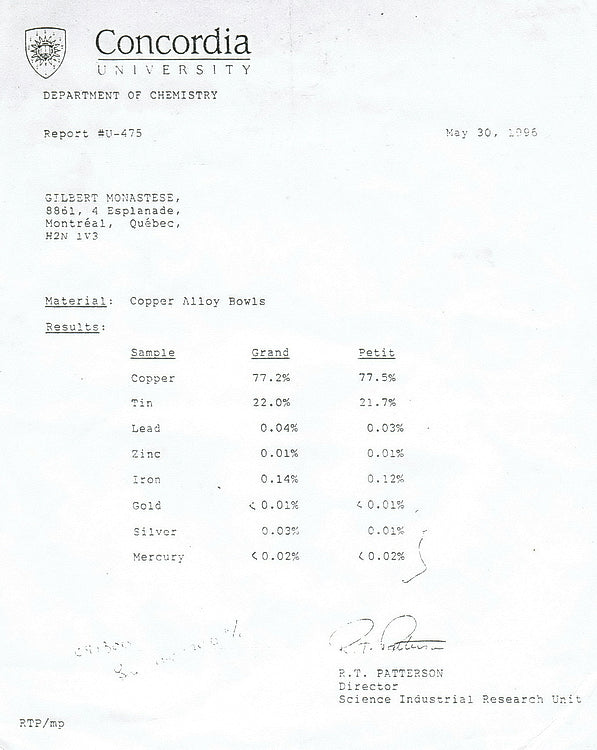
Singing Bowl Physics and Metallurgy: a Chat with Dr. Jeffrey Thompson
Share
May 19, 2011 - by Shakti
Last Summer, I posted a video on Facebook aired by the BBC entitled “On How Tibetan Singing Bowls Are Making Waves in Physics”. The following guest blog includes ensuing comments by Dr. Jeffrey Thompson, D.C., B.F.A C.N.S.T./ Diplomate. Dr. Thompson is a foremost leader in scientific research using sound therapy for altering brainwave states for mental, physical and emotional healing. Steve Sklar, a musician and sound healer joined in as the thread of conversation meandered from physics of singing bowls’ waveforms to their metallurgy. A debate ensued on the subject of the Oxford metallurgical analysis of singing bowls commissioned by Himalayan Bowls that reported the bowls were made of an alloy almost exclusively of copper and tin. I quoted an earlier analysis done by Concordia University in Quebec that may have resulted in the famous “7 Metals” alloy, which included gold and Mercury. Sorry, folks, I’m just getting around to posting the paper now. Enjoy!
Say something about this…
www.bbc.co.uk

-
Aedan Kelly and Steve Sklar like this.
-
 Jeffrey ThompsonNice one…..scientists eventually get around to discovering what the sages have known for millennia…July 2 at 12:52pm · Unlike · 2 people
Jeffrey ThompsonNice one…..scientists eventually get around to discovering what the sages have known for millennia…July 2 at 12:52pm · Unlike · 2 people
-
I demonstrate these effects in my Sound Healing workshops (without the slo-mo video, of course). But I usually prefer to use larger bowls for a better effect/view. You can vary the amount of water to get either wave patterns and/or fountain effects.
July 2 at 12:52pm · Unlike · 1 person -
I do think, however, that common historical notion, “mainly used for ceremonial purposes” tends to be an overstatement.
July 2 at 1:12pm · Like -
I also do this same demonstration with water in the bowls….the big crystal bowls work bets as a demo because of their large diameter. Another cool demo is to lay a nice big speaker on its back and fill the cone of the speaker with water and play sounds and music through it.
July 2 at 2:15pm · Unlike · 1 person -
Jeffrey: I’d expect the glass bowls to act somewhat differently, as they’re usually much louder with less harmonics. No?
July 2 at 3:28pm · Like -
correct…its a good demo of sound becoming visible because of the clear resonant patterns in the water, each metal bowl shows a much more complex wave form since Tibetan Bowls have multiple frequencies…monophonic binaural beats.
July 2 at 3:38pm · Unlike · 1 person -
Yeah, it’s strange when some glass bowl enthusiasts/dealers go on about the “wondrous harmonics” they produce. Not that many “Tibetan” bowl proponents don’t make false claims, too. Sigh…
July 2 at 3:40pm · Like -
Ive done extensive spectral analysis studies of Tibetan Bowls, you can clearly see from two to 4 peak frequencies per bowl…all within the critical bandwidth of one another. Definitely creating a brain entrainment pulse pattern per bowl. Since the interactions of different diameters of the bowl’s shape equal binaural beats, but these beats are not from two separate sources, but contained within the structure of a single bowl, I have named this “Monophonic Binaural Beats”. By the way, whenever I think I’ve discovered some new, cool, 21 century, futuristic application of sound for healing or changing consciousness, I usually find that the Tibetans did it first a few thousand years ago……July 2 at 3:45pm · Like · 1 person
-
Re: the binaural aspect, seems more accurately stereo to me, especially when the bowls are placed in front of one’s face; very different than when played lower down, on a table, floor, etc.Esp. interesting to me are the recent metallurgical analyses of singing bowls…
July 2 at 4:11pm · Like · 1 person -
Between 1970-1977 I owned a company that involved alloying and smelting metals, mold making and casting. I was heavily involved in the mixing of custom alloys of bronze, brass, and pewter. It has been pretty obvious to me that most Tibetan Bowls are a custom alloy of “Bell Bronze” which is a certain mix of mostly Copper and lesser % of Tin. Brass, btw, is Copper and Zinc. It would be a very difficult proposition for early metalsmiths to include high melting point metals like nickle and especially a very high melt point metal like iron. Most Bowls are an alloy of Copper and tin. I think it is a myth that some ancient bowls were made of meteorite material, since most meteorites are iron and some iron / nickel.Jeffrey Thompson (Quoting Himalayan Bowls’ article)
-
“Scientists at the University of Oxford studied a group of antique singing bowls from Himalayan Bowls during 2010. Archaeological Metallurgists from the renowned university’s Department of Materials have confirmed Himalayan Bowls’ own metallurgical analysis and dating assessment of antique singing bowls. Dr. Peter Northrup and his team examined a group of antique bronze bowls from 16th – 19th century, including one bowl that could be much older…
-
“Singing bowls are made from a high-tin bronze alloy. This special alloy is made from 77-78% copper, 22-23% tin. This type of metal is known as “bell metal bronze” and is found in most of the world’s best bells, gongs and cymbals. The high tin content is partly responsible for the beautiful tone produced by singing bowls. Very little variation in the alloy has been found in more than 100 singing bowls tested by Himalayan Bowls…“According to the scientists at Oxford, the high tin content makes the bowls less likely to crack during manufacturing. They were impressed by the craftsmanship. Himalayan Bowls’ research found a few singing bowls containing less than 2% iron. Other than these exceptions, all antique singing bowls tested contain only copper and tin…
-
“The pure bronze alloy used in singing bowls shows real mastery and knowledge of the material. The hand hammering annealing technique used to make singing bowls goes back 4,000 years. Singing bowls are a last remnant of an ancient metal working tradition. Bronze bowls have been made in the Himalayas for centuries – perhaps for 1,000 years. The new handmade singing bowls offered by Himalayan Bowls are made of the same high quality bronze as the fine antiques…
-
“It is remarkable to think that our singing bowls are part of one of the world’s oldest crafts and that the materials and techniques have remained unchanged for thousands of years.”
-
Wow I actually was off Facebook all day and I come back to find this. Thanks for the cool thread, Jeffrey. Actually the British Museum posted a different alloy composition of Tibetan bell metal that was much more varied – I’ll try to scan it & post it. Joseph told me about the analysis he did. I find it hard to believe that there was so little variance in the alloy content, considering that the bowls were made over such a broad geographic span and over such a long period of time. It makes sense to me that the ancient metal smiths utilized the raw materials available to them; and it makes sense to me also that the metal smiths varied their alloys according to the density of the metal bowl they wanted to produce, which would affect the harmonics produced.July 2 at 9:32pm · Like · 1 person
-
Have you seen the metallurgical analysis of the bowls done by Concordia University in Quebec? That’s the one where the whole “7 Metals” thing came from apparently. I’ll try to put my hands on that one and post it as well just for fun!
July 2 at 9:34pm · Like -
Jeffrey ThompsonI would really like to see that one.July 2 at 10:58pm · Like
-
I think part of the reason that the bowls alloy has been so generally consistent over time is the availability of copper and tin (and zinc for brass) and also because they all have a similar melting point that can be achieved without extraordinary measures for blast furnaces, etc. The monophonic binaural beats in the bowls is a function of the bulging shape of each bowl and is unique and the harmonics are partially a property of this and a property of the alloy itself. Minor shifts of % of copper to tin can make a very large difference in quality of tone, harmonics and brilliance. Also the sophistication of the purity of the molten metal and skimming of dross techniques applied. There is a real art to alloy making, mold making and casting of metals. I always felt like an alchemist when I was doing it myself….July 2 at 11:04pm · Unlike · 1 personHere it is, Jeff. Sorry for the delay…Regarding The British Museum Study we have referenced by W.Z. Oddy and W. Zalf (Occasional Paper no. 15, 1981), that will be the subject of another edition. Anyone with any other info on any other analyses published, I’d be happy to include them in future editions.
-
For those of you who interested in knowing what Dr. Thompson means monophonic binaural beats, that blog will be in the works as well.
-



